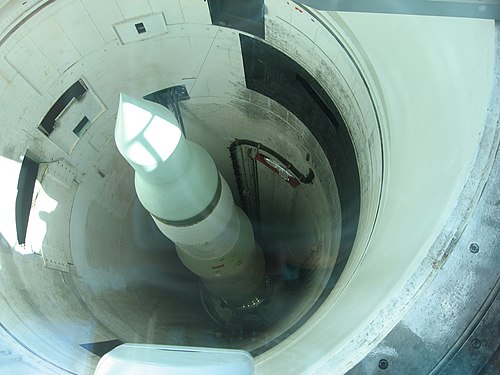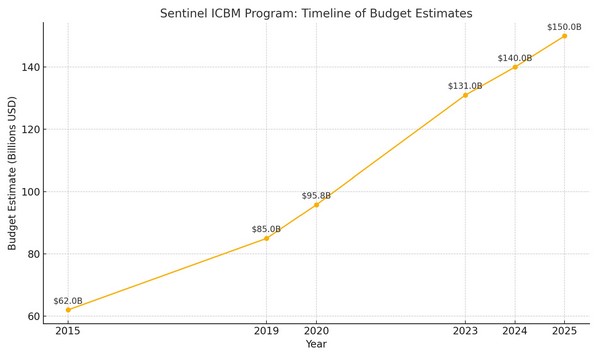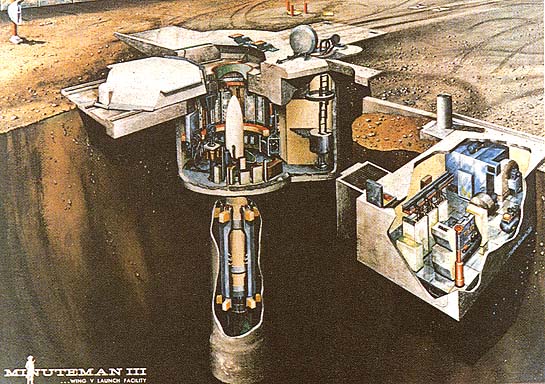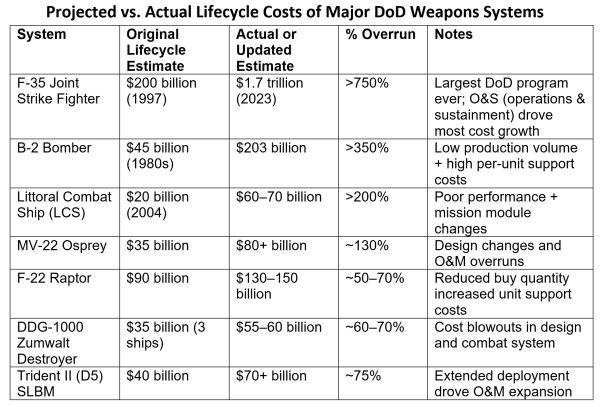There are 400 nuclear missile silos in the central United States that constitute the land-based component of the U.S. nuclear deterrent. The Minuteman III missiles in the silos are roughly 50 years old. Although they have been repeatedly upgraded over the years, the Air Force decided a replacement should be developed. The new missile under development, the Sentinel, has turned into a classic case of a mismanaged weapons program.
Minuteman missile in silo – time to retire?
The initial concept of the Sentinel missile program was to directly replace the Minuteman III missiles in the existing launch silos. By reusing the silos, the project was made cost competitive with the alternative of another life extension for Minuteman or a switch to a mobile missile concept. Although at the start Boeing and Northrup Grumman competed for the contract, Boeing withdrew in 2019 and Northrop became the sole bidder. Projected costs began to climb sharply after this point and in January, 2024, the Air Force notified Congress that the Sentinel program’s costs had exceeded baseline projections by more than 25%, constituting a critical Nunn-McCurdy cost limit breach. This breach mandated a formal review and certification process to determine whether the program should continue.
In July of 2024, the Department of Defense completed its Nunn-McCurdy review. The Under Secretary of Defense for Acquisition and Sustainment certified that the Sentinel program met the necessary criteria to proceed. However, he rescinded the program’s Milestone B approval and directed a restructuring to address cost overruns and management issues. It remains to be seen whether Northrup Grumman will make substantial changes to curtail the cost of the program.
Digging for Dollars
The most remarkable development in the course of the runaway cost estimates for the Sentinel missile is the recent decision to build new silos instead of reusing the existing ones. In May 2025, the U.S. Air Force announced that the Sentinel ICBM program would require the construction of entirely new missile silos, adding billions to the cost of the project. This decision was made after assessments revealed that the aging Minuteman III silos, some approaching 100 years old by the end of Sentinel’s expected service life, could not be adequately adapted for the new missiles. Factors such as structural degradation and the need for extensive modernization were the basis of the determination that building new silos was more practical and cost-effective than retrofitting the old ones.
Minuteman silo complex – too hard to fix?
Asserting that “structural degradation” has occurred in reinforced concrete structures designed to survive a near-miss by a nuclear weapon is puzzling to say the least. Moreover, the notion that modern fiber optic linked control infrastructure could not be retrofitted in structures accommodating far bulkier analog cabling and old electronic systems is highly questionable. In addition, there is a fundamental concern regarding silo construction: modern nuclear missiles are accurate enough to destroy even the most robustly constructed silo. The accuracy of ICBMs is now within 30-50 meters of a target. There is no feasible silo design that can survive a near hit (within 100-200 meters) by a modern earth-penetrating nuclear warhead. This makes attempts to improve on the hardening of existing silos pointless. The survivability of missile silos is now largely a myth sustained by institutional inertia and defense contracting incentives.
Minuteman missile site locations
The Mischievous Magic of Nuclear Deterrence
Perhaps the greatest boon conferred on the defense industry by the nuclear era is the elusive concept of deterrence. Like Schrodinger’s cat, it exists concurrently in two contradictory states. It is always absolutely vital, yet perennially insufficient. Its advocates maintain that it is working faultlessly because we have been spared nuclear attack, while simultaneously maintaining that we are in imminent danger of losing deterrence unless we spend large sums to preserve it. The magical property of deterrence is that there is no measurable connection between money spent on deterrence and the corresponding amount of deterrence secured. This is because deterrence exists in the minds of potential attackers, whose psychology is unknown and unknowable. Yet deterrence is deemed so important that it functions as a major justification for any new nuclear weapons program. The deterrence argument has become a fountain of riches for the makers of strategic nuclear weapons.
Magical thinking about deterrence is abundantly displayed in the dubious design decisions of the Sentinel missile program. Originally intended as a simple replacement for the ageing Minuteman III land based missiles, Sentinel has turned into a runaway weapons program, with projected costs greatly exceeding initial estimates. Sentinel program advocates invoke the magic of deterrence as justification for every costly feature added to the missile. They argue that a bigger payload, longer range, and more survivable silos will all add to deterrence, so why should we quibble over another hundred billion dollars?
Development Risk vs. Development Grift
There is a legitimate argument for accepting risk in weapons development if the goal is a quantum leap in capability. The development of stealthy combat aircraft provided a measurable military advantage over potential adversaries, and thus cost and schedule overruns of these programs could be defended to some degree. However, the Sentinel program, like several other mismanaged U.S. weapons programs, does not deliver a significant new capability but provides dubious “improvements” at enormous expense. Defense contractors, military leaders, and politicians all have incentives to overstate the value of such programs and understate their costs, knowing that once started the momentum of a big weapons project is hard to stop. This problem does not end with the development of the weapon. The grift that keeps on giving is the lifecycle cost, the cost of supporting a weapon system during its operational lifetime. This cost is also chronically underestimated, and the main beneficiary is again the defense contractor. There is reason to believe that Sentinel will follow this pattern and have lifecycle costs exceeding current estimates of $250-$300 billion.
Conclusion
The Sentinel missile program is yet another mismanaged U.S. weapons program exhibiting the chronic flaws of a procurement system distorted by perverse vendor incentives and failed governmental oversight. The Secretary of Defense should immediately order changes to the Sentinel missile program to utilize the current Minuteman launch infrastructure, with minimal required modifications of existing facilities. Since no silos can survive attack by modern ICBMs, building new silos would greatly inflate the cost of the program while adding little operational capability. The willingness of the current Defense Secretary to make these changes will be a test of the Trump administration’s seriousness in eliminating waste in government operations. If the Defense Department does not act to contain the cost of this program, Congress should make continued funding contingent on implementing a sound design approach based on an independent review by experts outside the influence of the Pentagon and the contractor. Northrup Grumman should heed some common sense advice: If you find yourself in a hole, stop digging.







Instead of maintaining nuclear weapons, which are not very useful, resources should be allocated toward developing supersonic missiles like the Oreshnik.
One can’t help but think that this all will be moot when the madmen running the world’s nuclear powers pull the triggers on their arsenals. I read somewhere many years ago that the likeliest survivors will be roaches and rodents.
Maybe we should revive the underappreciated MX-W program, where mobile ICBMs would be concealed in Wiinnebagos, provided to trustworthy citizens. Really, it makes about as much sense, eh?
Ever feel like you’re living in a Kafka story?
Actually, I vaguely remember a serious proposal made in the 1980s for a new organization of the nuclear deterrent based on ICBMs launched from vehicles (the kind of mamooth transporters the Russians have for their TOPOL missiles). Those vehicles would be parked in underground bases scattered all over the USA, and would randomly move from one such base to another. Since many vehicles would always be on the move all over the USA, it would be impossible for an enemy (i.e. the USSR) to disable all launchers. Attacking the “garages” would also be pointless, as very often they would be empty, the launchers being driven to-and-fro.
The scheme was ultimately shelved because of the maintenance requirements for a large fleet of launchers always on the move, the impracticality of having those large, heavy vehicles driving over the normal road network if not on dedicated tracks, and the sheer cost to set up the required infrastructure at scale.
I recall seeing an interview with Karakayev (the chief of the Russian Strategic Missile Forces) in which he was asked why the Americans have no road mobile ICBMs.
And his answer was that in Russia the SMF have the whole vast expanse of boreal forests all to themselves, plus they can do whatever they want with the road network. So they can move freely and conceal themselves well.
But in the US that is near impossible because most land is private.
The public land in the US is mostly in dry barren desert where there can be no concealment and in mountainous terrain in western states, where it would be difficult to move the very large ICBM TELs up and down and around tight corners.
The northern Michigan-Wisconsin-Minnesota region is too small for effective concealment even if all the woods there were public land, but in fact most of them are not. The largest contiguous tract is the corner northwest of Lake Superior.
If Canada is annexed one day, it is a wholly different story I guess, but for now the American commitment to private property prevents ICBM TEL deployment.
Which is indeed the most cost-effective way of doing it.
Of course, North Korea is tiny too, and they are relying entirely on road mobile ICBM TELs, which they are presumably hiding in their mountains. So in principle it should be possible to use the vast terrain of the mountain West states for the same purposes. What you are suggesting. And what the Chinese did a long time ago. Dig a vast tunnel network with 10-fold redundant exit points, fill it up with ICBM TELs. Should be doable, right?
P.S. One additional consideration to note is that the US ICBM silos serve a dual purpose — they are one leg of the triad, but they are also a sponge for Russia/Chinese missiles, because they would have to be hit first in any real exchange. The real US nuclear force are the SSBNs.
Once upon a time the USSR had 1,500 missiles just in the land component, but today there are several times fewer, and there are many times more US bases to disable all over Eurasia too, so if you do the math, you quickly realize that Russia might be quite constrained in its capabilities by the mere presence of those 450 ICBM silos unless there has been a huge stealth ramp up in warhead and missile production in the last few years, but there is no evidence for that.
P.P.S. Here is the documentary that interview was in:
https://www.youtube.com/watch?v=EFi2z3g1nQs
https://www.youtube.com/watch?v=sXH9s-x7qYU
Pakistan does that, and it’s a great way to lose a nuclear weapon, if you ask me.
Why would ICBMs have to be mobile or for that matter have bomb proof silos? These missiles would have been launched long before being hit. Even if the enemy had stealth missiles, they would still have to hit all targets simultaneously for a surprise attack to work.
It has all to do with a second strike, i.e. the capability to launch a retaliatory volley after being hit by an enemy who relied upon a first strike to achieve victory.
For static missiles, the silos have to be bomb-proof to sustain a first attack and being able to retaliate afterwards. The number of incoming ICBM (especially MIRV ones) is expected to significantly exceed the number of silos, or silo locations.
Mobile launchers achieve survivability by escaping a first strike that is targeted at fixed missile locations. They are not bomb-proof, but they survive because the enemy cannot win a whack-a-mole contest against transporters moving around unpredictably.
In summary, this is all part of the theory of deterrence.
Which begs for the questions, “Do the Russkies have third strike capability? Isn’t there a third missile gap we should be worrying about????”
This ‘deterrence logic’ leads nowhere. Thank you for making it so plain, Haig.
Oh, pick me, pick me! I am patriotic and can be trusted with fissile material!
Deterrence is a faith-based way of thinking. No one can prove a negative. So while one can point to innumerable instances when deterrence failed, one would be hard pressed to prove a case when it succeeded. Its a case of “did you prevent the war that didn’t happen today, or were you just lucky.” In more than a few cases, attempts at deterrence led to war. Moving the U.S. battle fleet from San Diego to Pearl Harbour to “deter” the Japanese is one such case. Yamamoto saw them as coming within reach. Arguably, NATO expansion eastward to “deter” Russia is another.
Minor correction: the battle force was actually based in San Pedro with CRUDES and SUB forces at San Diego.
As far as moving the fleet to PH, it is interesting question as otherwise would there have been the same PR campaign about the “ABCD” powers? If the IJN couldn’t argue that the fleet was an implied threat what would the impact have been in Japan’s move to Indochina and the Dutch/Brit colonial holdings?
As we saw in 1982 the West makes a point of not understanding their opponent’s intentions.
When Reagan and Thatcher went into the bunkers during Operation Able Archer II the Soviets were so terrified this was it that we almost had a nuclear conflagration over nuclear chest-beating disguised as an exercise. Reagan got such a shock that he re-evaluated his whole foreign policy and some say it drove him into senility.
Time and time again our ‘estimates’ of what our self-declared ‘opponents’ think has proven to be a combination of our own greed and wishful thinking. When suddenly confronted with the reality we’ve had to do very sharp changes in policy. But if you take the long view you see that this policy has never really changed, simply the tactics.
This in part smells just like the same rotten syndrome that played out in my kids’ school budget about 8-10 years ago.
Accurately it was diagnosed that the school and town did not have sufficient athletic fields to support school and community activities and allow these fields to remain robust during periods of heavy rain – there was no time for them to recover.
So what happened… well the local athletic booster club (kind of like Washington lobbyists) came up with a bunch of cash to hire an outside consulting company to do a field review and make a series of recommendations to the district. What could possibly be wrong with asking experts what our real options are? Personally, this is a solid logic decision, assuming you can actually evaluate and hire NON-Biased experts.
Well the experts concluded that the district need to improve drainage on several fields, but even that wasn’t going to be enough and that they needed 3 brand new artificial turf fields which would require replacement of the turf every 10 years at about $100k per replacement plus disposal/landfill costs..
Well being that we lived in a wealth community this was just taken as what we needed. Nobody seriously questioned anything. NOT EVEN the fact that those consultants happened to be a subsidiary of a company that manufactured, sold and installed artificial turf fields.
Reads like a pretty good pitch for a Netflix sitcom with lots of scope for hilarious sub-plots about day to day life in the MIC&C, with generals groping for post-retirement Board seats, politicians with hands outstretched and lots of laughs from military contractors brainstorming new ways to hypothesize unforeseen forms of obsolescence requiring additional government handouts.
Well, in the real world instead what you get is this:
Hollywood Goes to NATO: Telling the Story of the Alliance
July 12, 2024
47 min.
https://www.csis.org/events/hollywood-goes-nato-telling-story-alliance
p.s. I fully agree with the idea you just pitched. But find a single producer doing that. It would be a death sentence figuratively. Netflix´s “SPACE FORCE” is about as critical as you can be. While it had some merit characterwise on the political level it’s more than benign…
p.p.s. Considering the increasing level of war crimes perpetrated and supported and enabled by the West the complete lack of features and series addressing this is deeply shocking. NEver ever did we have so much material out there to use. Not a single person is touching.
The more crimes (domestic and abroad) are committed that could be turned into movies the less those movies are actually made. Money as such cannot be the cause. There is a reason why conspiracy stories are among the best sellers in motion picutre history. Obviously your average ticker-buyer is much more smarter than the culture & arts staff of the NEW YORKER.
edit: Sorry the many typos. Am in a hurry.
The best analogy/joke about deterrence I ever encountered was that relying on deterrence was like being a turkey: everything is roses and sunshine, but sooner or later Thanksgiving is going to roll around.
Why the need for silos if you have a functioning Golden Dome?
https://www.defense.gov/News/Releases/Release/Article/4193417/secretary-of-defense-pete-hegseth-statement-on-golden-dome-for-america/
I have read, and it seems plausible to me, that a highly effective missile defense system is inherently destabilizing because it lowers the risk, to the possessor of the system, of a first strike against an adversary that does not have an equivalent system. This in turn invites the adversary to strike before the defense system has become operational.
Perhaps one needs to maintain hardened silo-based weapons to retain second-strike capability against this pre-emptive first strike.
—
The whole thing is a nightmare.
Where did leaders of Reagan’s stature (on the subject of strategic arms reduction) go?
Naked Capitalism has had articles and links since the Pakistan and India flare up. For me, deterrence is the total destruction of life as we know it. This is another good article on continued looting of the wealth of the USA that accumulated over 200 years. The elites have seceded from the Union.
It is worse than looting, as in looting the wealth is moved to different hands but not transformed.
The USA has destroyed many lives, useful metals, minerals, hydrocarbons and creative capacity pursuing the “defense” dream.
The wealth is being destroyed, as in being made economically unusable/unrecoverable, and is not simply looted.
An example is the ongoing attempt to repair defense related self inflicted damage (Hanford, WA, plutonium enrichment plant) which has a very high cost, if even feasible.
It would be great if the wealth were recoverable loot.
Isn’t it past time for those DOGE boys to head over to the Pentagon? Is it because they lack badges? Thought they didn’t need no stin-king badges (sorry couldn’t resist).
Near Tuscon one can tour an old Titan silo.
https://titanmissilemuseum.org/
I believe they were once going to make it a state park but now private and pay. The Titan was liquid fueled and not very practical but then is any of it practical? Perhaps the chowderheads who run our military are the ones who should lose their badges.
With the advances in Russian missile design with hypersonic missiles, it may be that they have the drop on all those old Minuteman III missiles in their silos. Since the US has been unable to develop their own hypersonic missiles, the idea seem to be to build a tarted-up version of the Minuteman III missiles so really is more of the same. That and trying to station US nukes on Russia’s borders like in the Ukraine. Doesn’t really matter as the whole thing is just a washing machine. US taxpayer money goes into these systems where it swirls about and out the other end comes some dodgy system that barely works – lots of people get to but second and mansions.
Since there is no defense against the *current* generation of ICBMs, the advent of “hypersonic” missiles changes absolutely nothing.
The significance of the Oreshnik is NOT that it’s faster, or harder to defend, or more powerful than ICBMs; it’s not. It’s that there isn’t a nuke at the pointy end. You get all the guaranteed hit / can’t defend against pluses of an ICBM, without the minus of ending the world.
There’s nothing stopping the West from doing the same; other than the inability of the MIC to build defense systems on a budget (the whole point of Haig’s post.)
Isn’t theory the same as practice?
And are we not the last one standing then!
Have some trust in our glorious and highly competent leaders!
https://www.mda.mil/news/25news0002.html
Although there is no reliable defense for a large area against nuclear missiles, it should be possible to construct a point defense system, which could at least force the missile to detonate a kilometre or so away from its target. This would ensure that missile siloes were survivable and would do a lot for deterrence. It should also not be tremendously expensive (although it would be expensive enough to immensely benefit the contractor, so it would be worthwhile for the military-industrial complex.
I don’t fully understand why this has not been pursued. Incidentally, why is it that every other major nuclear power has been able to develop new nuclear missiles while the US is still relying on 1960s devices? It certainly isn’t for reason of moral scruples or shortage of cash.
Just a few quick points on this:
First off, there is a lot of confusion about bunker busting munitions. Because of loose terminology, there are assumptions that there are earth penetrating nuclear warheads – so far as we know, these don’t exist, and if they do, they are only capable of quite shallow (and probably essentially worthless) levels of penetration. The reason is pretty straightforward – the kinetic velocities needed to penetrate rock are such that it would be exceptionally difficult to design a warhead that could survive the first nano-seconds of impact. This is the reason why bunker busting warheads generally use conventional explosives. The experiments with nuclear earth penetrators that we know of involved relatively low velocity penetrations (i.e. dropped from an aircraft, not from a ballistic missile). While conventional ballistic penetrators can be very effective, they rely on a very high degree of accuracy and a high level of information on the depth and layout of the structure they are attacking. Rock is very good at absorbing the released energy, so you have to hit your target very precisely to do real damage.
This is why underground silos are generally very useful against nuclear weapons (and pretty much everything else). Even the largest warhead will produce a fairly minimal level of ground disturbance. And to achieve very high degrees of accuracy (conventional or nuclear), you generally have to slow the warhead down to below hypersonic speed, making it easier to intercept. Busting well engineered underground rock structures is an exceptionally difficult technical task, one probably (so far) beyond any countries ability.
The second point around the structural integrity of the minuteman silos – its perfectly credible that these are now unusable. Underground concrete structures, unless specifically designed for a very long life (which is quite difficult, as they are by definition within a very chemically active environment) will degrade after several decades. A particular problem of reinforced concrete structures is that rotting or degradation is hidden away, and is often very difficult to identify, and when it becomes apparent its often too late, the damage has gone too far. Its also very difficult with any concrete structure to retrofit, as removing parts can undermine the structural integrity of the entire structure (this is why steel buildings are much easier to retrofit than concrete ones).
You are correct in pointing out that earth penetrating warheads are not currently deployed, but the technology does exist. The W86 earth-penetrating nuclear warhead for the Pershing missile was developed in the late 1970s for the purpose of destroying soviet missile silos. The project was cancelled not because of feasibility reasons but because of concerns for increased radioactive fallout and political resistance in Europe leading to decisions not to deploy the Pershing missile. I referenced the earth penetrating warhead capability because it is the counter to any conceivable silo hardening strategy. Existing silos are already assured of destruction by multiple warhead strikes in the 300-500 kiloton range, with three warheads giving a 99% kill probability given current accuracy capability.
I consider the silo structural degradation claim to be questionable for the following reasons:
1. There was no prior concern regarding this issue expressed by the Air Force as justification for the Sentinel program. Their complaints about existing launch facilities were about outdated equipment, not the condition of the massive reinforced concrete structures. Since these facilities have been inspected, maintained, and upgraded for decades, it is not credible that they are now found to be seriously defective.
2. Even if there were serious weakening of the concrete silo structures, reducing blast resistance, the difference would be irrelevant given the adversary attack strategy of an assured kill of even a perfectly intact Minuteman silo.
3. There is an obvious perverse incentive for Northrup Grumman to add new silo construction to the program.
Given the normalized corruption of the MIC, and the track record of past big-ticket defense projects, there is little basis for trusting claims made by the proponents of the Sentinel program. Critical scrutiny of this program is warranted and long overdue.
The Pershing II had a ‘pull up’ mode in its terminal phase to slow the warhead down to achieve accuracy and penetration. It was a relatively short range missile and as such would not have had the velocities of a full ICBM mirv so far as I can see. It was also designed for the softer geology of targets like airfields. I’m not aware of any proposals for putting this type of warhead on any full icbm, despite its obvious usefulness. I’ve always assumed this is due to the technical difficulties, but of course much of the information is not openly available.
Assessing historic reinforced concrete structures is notoriously difficult. It can usually only be done through destructive testing – i.e. by drilling right into the structure. The interactions of modern concrete and various geologies over time is poorly understood – mostly because modern concrete mixes haven’t been around long enough. There are many examples of civil engineers getting very nasty surprises when making assessments of mid-20th century structures. Its known as a particular issue in desert areas due to high salt/sulphur contents in evaporation fields.
This isn’t to say it isn’t just an industry scam, but I don’t think any experienced civil engineer would be surprised at an assessment that reinforced concrete structures from that period can no longer be usefully re-used.
If any experienced civil engineer would anticipate the possibility of significant silo structural deterioration one must conclude that the initial estimate based on silo reuse was irresponsibly optimistic. It is commonly assumed that due diligence is performed in proportion to the magnitude of an undertaking. Thus, finding that the silos are unsuitable 9 years after gaining approval for a $60 billion project is either incredibly stupid or deliberately manipulative. I lean toward the latter conclusion.
I think the concept of nuclear “bunker busters” against silos is to penetrate the ground between the silos and the detonation is supposed to cause lateral seismic waves that will knock off equipment, cause spalling in the silo inner walls (filling the silo and the adjoined bunkers with concrete fragments travelling at high speeds) and possibly even throw enough material over the silo door to prevent it from opening.
Even in a nuclear war mission kills count, I guess.
A lot of the open source assessments are obviously based on guesses, but my understanding is that destroying entrances/ducts, etc., is considered the only feasible way to neutralise well constructed underground silos/bunkers in hard (granite or similar) geology.
Deep Dive Defence did a YT video on Iran’s bunkers recently which was quite interesting. I recall reading in an industry journal a while back on Iran’s use of concrete for military purposes (I can’t find a link right now). Iranian’s are considered world leaders in concrete design, mostly due to research going back decades on earthquake proofing their cities. It seems that far from just pouring a lot of concrete, the Iranians use quite sophisticated layering of ultra hard (quartz) concrete with shock absorbing layers using glass fibre layering, along with anti-spalling linings. Whether other countries have applied this to underground bunkers, I’ve no idea, but I assume there has been a lot of testing over the decades.
Btw, I don’t suggest expressing an interest in concrete stress design in front of a specialised engineer on the subject. They will be so surprised and happy to find someone who seems interested they will monologue you for hours on the topic.
As a nuclear exchange at scale means the end of civilization, maybe the extinction of most higher life forms, why are we still even having this ridiculous discussion. If the boys must have their toys, let them have a massive multiplayer game in which they can build missiles, design ever more elaborate and hellish means of
destruction, have wars, see the result, get their jollies, and then hit reset. Do it all again.
If we must have devastating weapons, would it not be better for the prospect of having a somewhat livable planet to have them be non-nuclear?
Iran must never have “the Bomb.” What is so special about Iran? I know the answer. On whom in its neighborhood can Israel use its bombs? Be like having a knife fight in a dark closet and what about the rest of us. India and Pakistan have “the Bomb.” They are having one of their periodic dust-ups. What happens if they use their nuclear weapons? What happens to the rest of us? Then there is the US, Russia, and China each of which have more than enough weapons to destroy the others and in doing so make the Earth all but uninhabitable by all save the oft mentioned cockroach.
I have been reading about the efforts in the 1980s to ban nuclear weapons. Depending on whom you believe, it came close to becoming a reality. Why did it fail? There were those who thought having “the Bomb” gave them an edge in the game of whose on top. I suppose that might make sense if there were other planets we might repair to having wrecked this one, but sadly there are not.
In sum: the Russians are not coming. The Chinese are not seeking world empire. The USA has those two broad oceans. None of the three can conquer the world. What possible good are nuclear weapons? They are costly to build and maintain and you cannot use them. Would we all not be better off without them? We would and to insist otherwise is … let’s see … insane or moronic or obsessed or paranoid or a war lover … probably many more that I cannot call up at the moment. Yes, this is a foolish and naive screed, impractical, can’t trust those others … have you tried … have you climbed down from your perch that is so desperately important to you and tried. Of course not. And why not? Well I have my suspicions but you would find them insulting to your amour propre.
I remember reading in the early oughts that the USA had by then spent some $9 trillion (!) on nuclear missle research, project construction, manufacture, and maintenance.
Another world is possible.
I assume Haig will do something about SSBNs too in the future…
Btw: I did write it last week but just to repeat here:
On the issue of Sentinel failure and repeated delay Andrei Martyanov suggested – a bit stretched maybe – that this Sentinel business could in the long run lead to the loss of one leg of the US nuclear triad. It would be impossible to find any confirmation from an official source. Which is why these things rely so much on extrapolation and speculation. But that again would be a major “domino to fall”…(sorry for using Acheson’s bullshit idiom here).
Martyanov’s comment about loss of part of US triad as suggested by RU experts due to Sentinel problems:
Catastrophe, Now!
May 7th 2025
see TC: 32:00+
34 min.
https://smoothiex12.blogspot.com/2025/05/catastrophe-now.html
links from that episode on the above mentioned silo problem:
Air Force now expects Sentinel ICBMs will ‘predominantly’ need new silos
“Part of the requirements, initially — ten years ago when this program was started — was to reuse the holes, the missile holes at the launch facilities,” said Air Force Gen. Thomas Bussiere. “Shockingly enough, if we look at it, that may not be the answer.”
https://breakingdefense.com/2025/05/air-force-now-expects-sentinel-icbms-will-predominantly-need-new-silos/
The Air Force’s New Sentinel ICBMs Are Facing a Silo Shortage
https://nationalinterest.org/blog/buzz/the-air-forces-new-sentinel-icbms-are-facing-a-silo-shortage
p.s. “Coffee Break”?! I spill my coffee every single time over these article subjects! 😂
No wonder the aliens stay away – the human race is not civilised enough to join the interplanetary community.
Navy pushing billions for sea-based nukes that nobody seems to want
Long deemed unnecessary, the re-upped SLCM-N venture could cost taxpayers — and national security — big time
Stavroula Pabst
May 22, 2025
https://responsiblestatecraft.org/navy-slcmn/